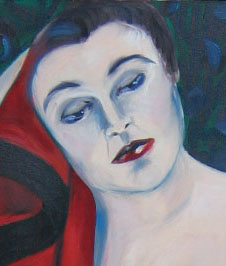Twenty Reasons
In Twyla Tharp's book The Creative Life, she takes an idea from Leonardo da Vinci who, in his notebooks, makes lists of twenty "aspects of rivers and currents he intended to study". She suggests as an exercise in thoroughness to write "twenty things you want to know about" whatever it is you plan to approach.
I'm doing this in hindsight since I've begun my Tangle series. Here's my list of 20 things I like about tangles.
1. The toy is fun to play with.
2. Invented by a sculptor.
3. It never makes a straight line.
4. I can "pose" it.
5. Creates a 3D calligraphic line.
6. Painting it feels a lot like painting the human figure.
7. Creates shadow patterns that are different from the image.
8. Looks like something that explains something else.
9. It's colorful.
10. It keeps the eye moving around the image.
11. It keeps the mind busy.
12. It looks like you could crawl into it.
13. Has multiple connotations.
14. Produces more ideas on how to represent it on canvas.
15. It challenges my ability to push the idea.
16. It's different from my usual subject matter.
17. It's objective.
18. The background color is subjective.
19. It's contemporary.
20. I like it.
I'm doing this in hindsight since I've begun my Tangle series. Here's my list of 20 things I like about tangles.
1. The toy is fun to play with.
2. Invented by a sculptor.
3. It never makes a straight line.
4. I can "pose" it.
5. Creates a 3D calligraphic line.
6. Painting it feels a lot like painting the human figure.
7. Creates shadow patterns that are different from the image.
8. Looks like something that explains something else.
9. It's colorful.
10. It keeps the eye moving around the image.
11. It keeps the mind busy.
12. It looks like you could crawl into it.
13. Has multiple connotations.
14. Produces more ideas on how to represent it on canvas.
15. It challenges my ability to push the idea.
16. It's different from my usual subject matter.
17. It's objective.
18. The background color is subjective.
19. It's contemporary.
20. I like it.

